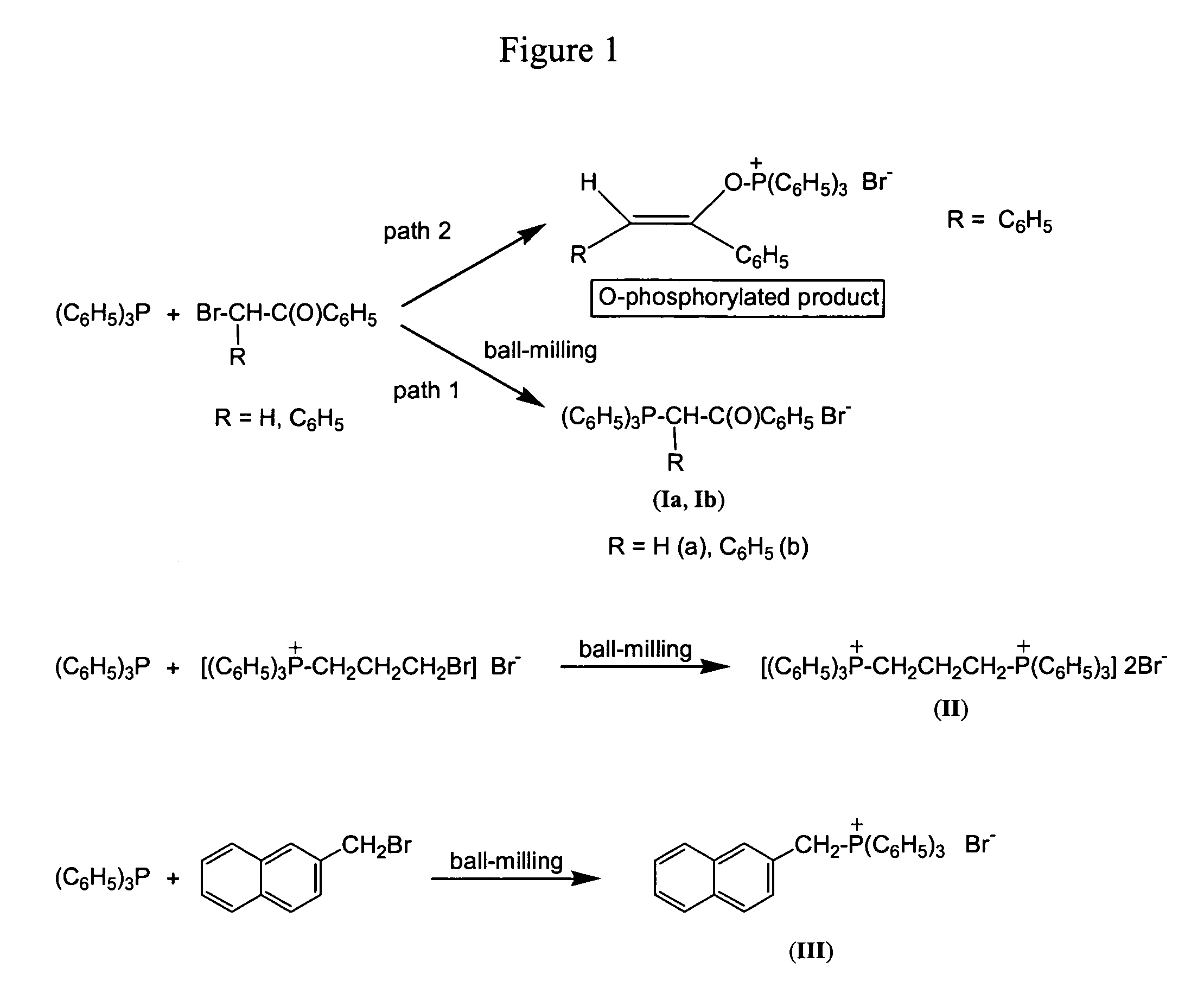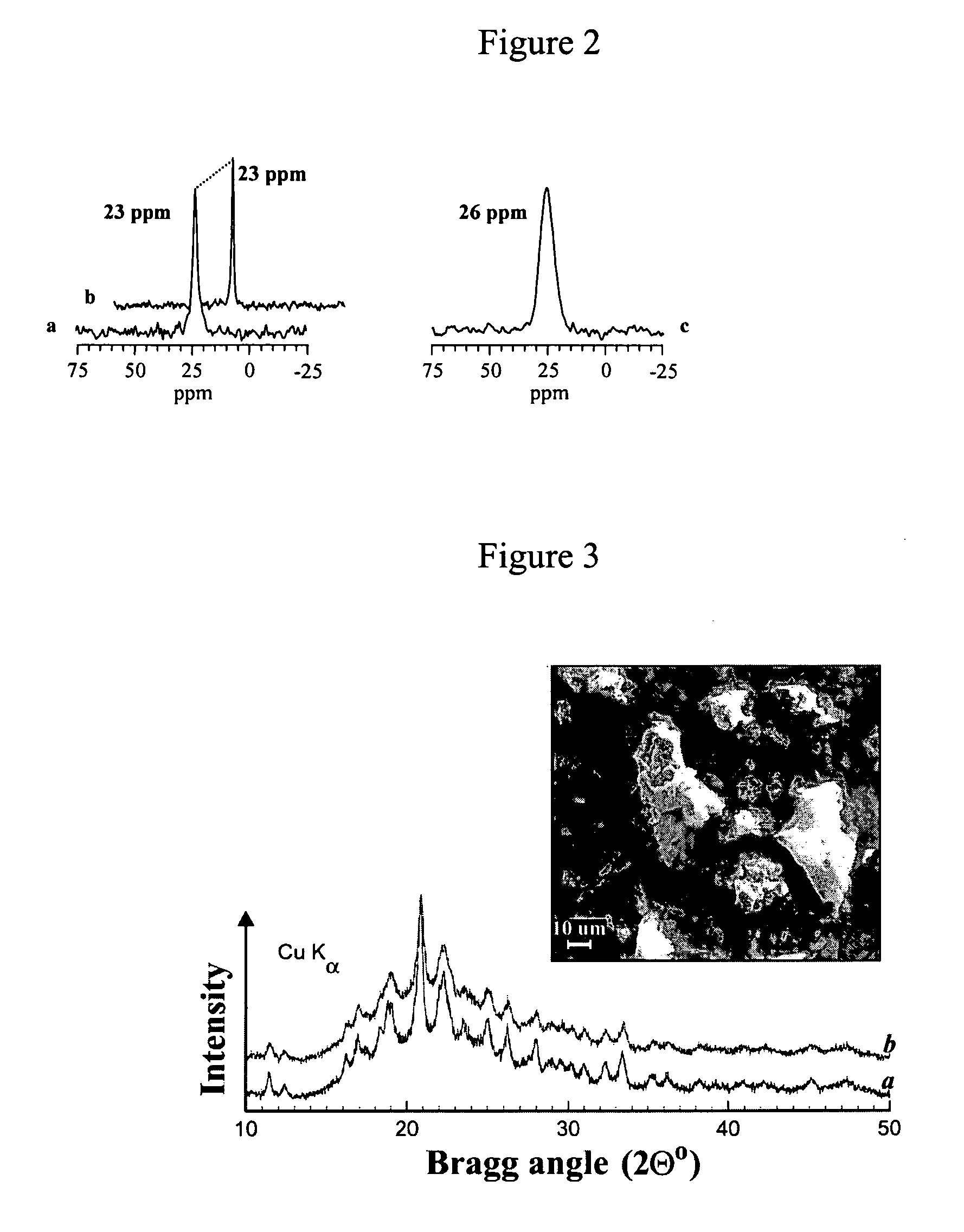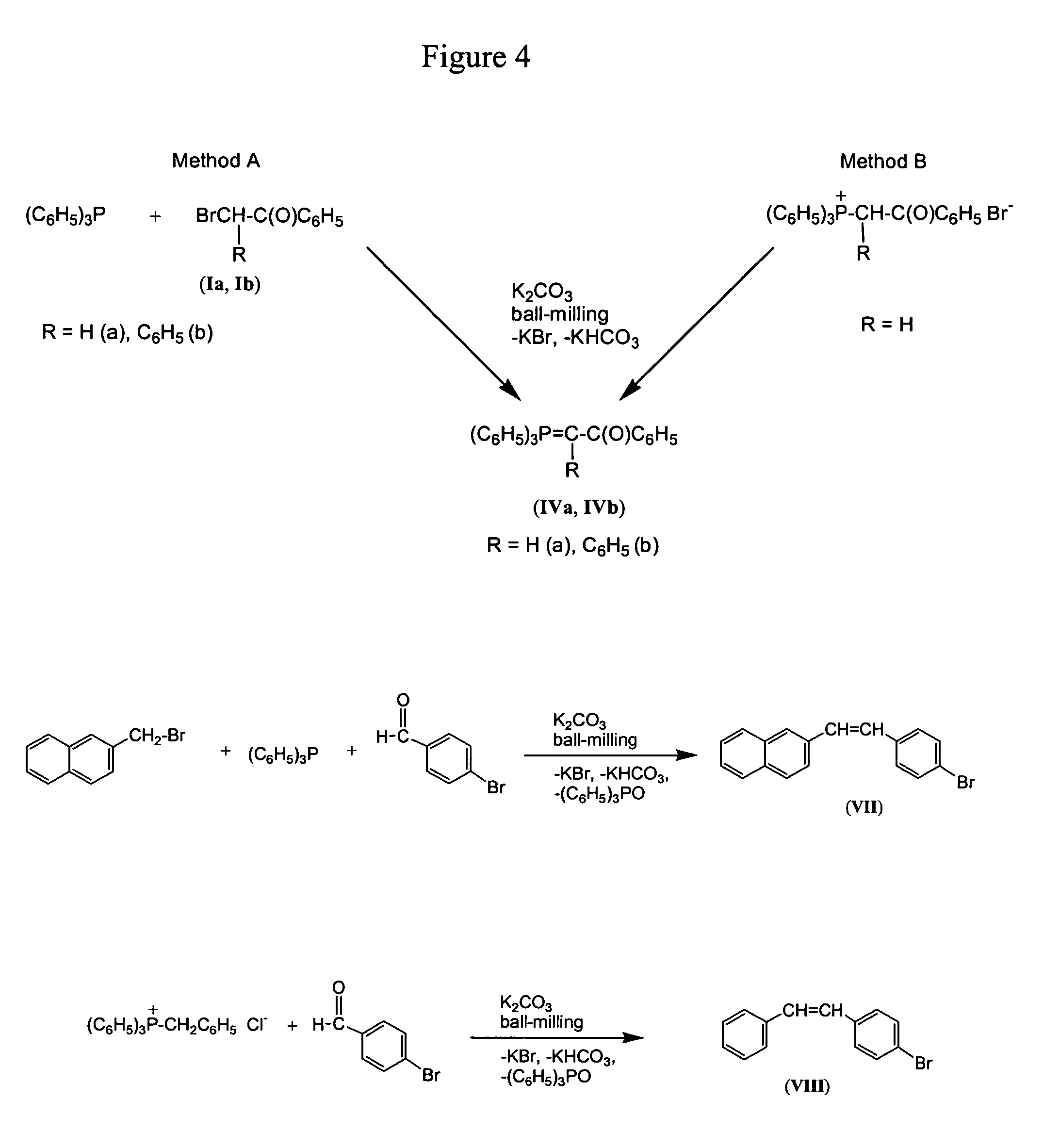Solvent-free mechanochemical preparation of phosphonium salts, phosphorus ylides, and olefins
a technology of phosphorus ylide and mechanochemical preparation, which is applied in the field of solvent-free mechanochemical preparation of phosphonium salts and phosphorus ylides, can solve the problems of complex generation of phosphorus ylides in solution, unreliable reaction of ternary phosphines with -bromoketones, and lowering the overall yield of desired compounds, etc., to achieve high selectivity of qua
- Summary
- Abstract
- Description
- Claims
- Application Information
AI Technical Summary
Benefits of technology
Problems solved by technology
Method used
Image
Examples
example 1
[0043]This example describes the preparation of phenacyltriphenylphosphonium bromide (Ia), FIG. 1.
[0044]Ia was prepared from 0.70 g (2.7 mmol) of triphenylphosphine and 0.53 g (2.7 mmol) of α-bromoacetophenone by ball-milling for one hour under helium. The resulting powder was analyzed by solid state 31P{1H} CP MAS NMR spectroscopy, and the salt Ia was re-crystallized from water for an additional purification. Yield: 1.10 g (90%).
[0045]Mechanochemically prepared phenacyltriphenylphosphonium bromide (Ia): solid state 31P{1H} CP MAS NMR: δ31P (ppm): 23.0; liquid state NMR (CDCl3): δ31P (ppm): 23.0; δ1H / JP-H (ppm / Hz): 8.38 / 7.4 (d, 2H, Ph), 8.01–7.90 (m, 6H, Ph), 7.67–7.74 (m, 4H, Ph), 7.67–7.54 (m, 6H, Ph), 7.52–7.45 (m, 2H, Ph), 6.40 / 12.2 (d, 2H, CH2); Mp 270–273° C.
[0046]Phenacyltriphenylphosphonium bromide (compound Ia in FIG. 1) was also purchased and used as a reference. Commercial phenacyltriphenylphosphonium bromide (Lancaster Synthesis): solid state 31P{1H} CP MAS NMR: δ31P (pp...
example 2
[0048]This example illustrates the synthesis of (α-benzoyl-α-phenylmethylene)triphenylphosphonium bromide (Ib), FIG. 1. It was reported previously that 2-bromo-2-phenylacetophenone reacts with triphenylphosphine in a solution following both path 1 and 2 shown in FIG. 1, thus yielding a mixture of C- and O-phosphorylated reaction products (Borowitz et al., J. Org. Chem. 34, 1595 (1969)). As a result, (α-benzoyl-α-phenylmethylene)triphenylphosphonium bromide (compound Ib in FIG. 1) is difficult to separate from by-products. The corresponding ylide ((α-benzoyl-α-phenylmethylene)triphenylphosphorane) is, therefore, usually prepared in a lengthy multiple step process which avoids the use of (α-benzoyl-α-phenylmethylene)triphenylphosphonium salts (Sanz, J. Carbohydr. Chem. 17, 1331 (1998)).
[0049]The salt Ib was prepared from 0.42 g (1.6 mmol) of triphenylphosphine and 0.44 g (1.6 mmol) 2-bromo-2-phenylacetophenone by ball-milling for one hour under helium. The sample for the liquid state ...
example 3
[0053]This example describes the preparation of propane-1,3-diyl-bis(triphenylphosphonium) dibromide (II), FIG. 1.
[0054]0.83 g (3.2 mmol) of triphenylphosphine and 0.50 g (1 mmol) of 3-bromopropyl(triphenylphosphonium) bromide were ball-milled in a tungsten carbide vial using 70 g of tungsten carbide balls for 12.5 hours. The resulting powder was analyzed by the solid state NMR spectroscopy, which confirmed the formation of the salt II, then treated with 100 ml of chloroform, filtered, and the solvent was removed under vacuum. The compound II was isolated in 51% yield (0.40 g) and additionally purified by re-crystallization from a methanol-hexane mixture.
[0055]Mechanochemically prepared propane-1,3-diyl-bis(triphenylphosphonium) dibromide (II): liquid state NMR (CDCl3): δ31P (ppm): 25.4; δ1H (ppm): 7.87–7.83 (m, 10H, Ph), 7.71–7.57 (m, 20H, Ph), 4.64–4.55 (m, 4H, CH2), 2.3–1.83 (m, 2H, CH2). Mp 355–360° C. (decomposition).
[0056]Commercial propane-1,3-diyl-bis(triphenylphosphonium) d...
PUM
 Login to View More
Login to View More Abstract
Description
Claims
Application Information
 Login to View More
Login to View More - R&D
- Intellectual Property
- Life Sciences
- Materials
- Tech Scout
- Unparalleled Data Quality
- Higher Quality Content
- 60% Fewer Hallucinations
Browse by: Latest US Patents, China's latest patents, Technical Efficacy Thesaurus, Application Domain, Technology Topic, Popular Technical Reports.
© 2025 PatSnap. All rights reserved.Legal|Privacy policy|Modern Slavery Act Transparency Statement|Sitemap|About US| Contact US: help@patsnap.com



